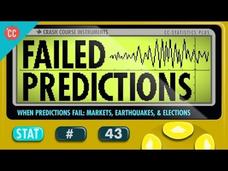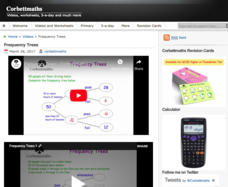GCFGlobal.org
Recognizing Persuasive Language
Lose 10 pounds in one day, guaranteed! With the sixth installment from the digital media literacy series, scholars identify common types of persuasive language. They learn to look beyond techniques such as telling stories, presenting...
GCFGlobal.org
How Filter Bubbles Isolate You
How do algorithms personalize each Internet user's online experience? Learners discover the answer in the fifth installment from the digital media literacy series. They explore the concept of the filter bubble, a term used to describe...
GCFGlobal.org
How Social Media Stars Make Money
Don't forget to like, comment, and subscribe! With the fourth video from the digital media literacy series, scholars learn how social media stars make money by gaining subscribers. They discover how paid advertisements, product...
GCFGlobal.org
How Ads and Clicks Shape the Internet
What impact do advertisements have on Internet users? Pupils explore the topic in the third video of the digital media literacy set. Scholars discover the tactics advertisers use to get people's attention (and clicks). They learn about...
GCFGlobal.org
Tips for Reading Webpages
How is reading a webpage different from reading a book? Scholars explore the topic using the second video from a larger digital media literacy series. Pupils learn tips for reading webpages more quickly and efficiently; specifically,...
GCFGlobal.org
Judging Online Information
Limitless knowledge is only a mouse click away, so how can people make sure they're getting the best information possible? Using the first video in the digital media literacy series, scholars learn how to evaluate the information they...
Corbett Maths
Converting Metric Units for Volume
The capacity for learning is great. Develop the conversion factors for metric capacities with a video presentation. The lesson narrator describes the origin of the factors and then shows how to convert between metric volume units.
Corbett Maths
Metric to Imperial Mass
Lift the weight of teaching unit conversions! A video presentation demonstrates conversions between kilograms, pounds, and grams. The narrator explains the conversion factors and then completes several examples of each.
Corbett Maths
Converting Imperial Length
What would you think if someone told you the speed they can run is 7,920? Not possible right? It is if it's 7,920 feet per mile! Young scholars view a set of examples showing how to make conversions between the standard units of length....
Crash Course
When Predictions Fail: Crash Course Statistics #43
The world relies on statistics for important predictions like earthquakes, volcano eruptions, and winners of presidential elections. Examine some popular failed predictions and identify their flaws while watching the 43rd installment of...
SciShow
Were the Planets Always in the Same Order?
Our solar system is just like the other solar systems, right? It seems that isn't quite true, but the differences give scientists information about the movement of the planets. An episode of the SciShow Space series describes the physics...
PBS
When Apes Conquered Europe
Where are they now? Apes are humans' closest evolutionary ancestor, yet they only live in small areas in Africa and Asia. Learn how their geography changes with evolution in a video lesson from the PBS Eon series.
PBS
When Rodents Rafted across the Ocean
You think mice can be a nuisance, wait until you meet the capybara! An installment of the PBS Eons series traces the genetic background of a large group of rodents known as the Caviomorpha. Fossil evidence indicates they originate in...
PBS
The Two People We're All Related To
Is it possible all current lineage trace back to one male and female? Mitochondria DNA suggest just that! A lesson with this interesting perspective on genetic heredity explains how all human DNA connects to a single male and female in...
Corbett Maths
Frequency Trees
It's time to branch out a little! Individuals explore the usefulness of a frequency tree when organizing data in a helpful video lesson. The instruction includes constructing a frequency table from a description and then using the tree...
Corbett Maths
Quantitative and Qualitative Data
Classify the Big Ben of all data with a video that defines quantitative and qualitative data. Given data about Big Ben, the presenter classifies each piece based upon the definitions. In the Types of Data worksheet, individuals show they...
Corbett Maths
Discrete and Continuous Data
Let's be discrete about the types of data. A short video provides the definitions of discrete and continuous data. After providing the definitions, the resource takes different types of data and sorts them based on type and provides an...
Corbett Maths
Volume of a Pyramid
All you need is the formula. Given the formula, a short video show how to find the volume of a rectangular prism. The presenter explains the different variables of the formula and uses it to find an unknown height. Worksheets provide...
Corbett Maths
Volume of a Sphere
The volume of a snowball's chances in ... Using a snowball, the video introduces the formula for finding the volume of a sphere. The presenter then talks the class through the process of finding the volume after determining the length of...
Corbett Maths
Volume of a Cone
Is it possible to find the volume of a cone? Of course! Using the formula for the volume of a cone, the video shows how to calculate an exact and an approximate answer for a cone's volume. The worksheets challenge pupils to perform...
Corbett Maths
Volume of a Cylinder
Circle up the base. Using the formula for the volume of a cylinder, the presenter calculates the volume of a given cylinder. The video shows that the volume formula for a cylinder and the volume formula for a prism arrive at the same...
Corbett Maths
Volume of an L-Shape Prism
The formula works no matter the shape of the base. A short video shows how to find the volume of a prism when the base is a composite shape created by rectangles. Handouts provide the class members opportunities to practice the skill and...
Corbett Maths
Volume of a Prism
Not all prisms are cubes. A short video introduces the definition of a prism and uses that definition to create a general volume formula. Worksheets provide pupils several opportunities to practice finding the volume of a wide variety of...
Corbett Maths
Volume of Cuboids and Cubes
Turn up the volume. After identifying the three dimensions of a prism, the presenter gives the formula for finding its volume. Using the formula, the video shows pupils how to find the volume of a rectangular prism and a cube. Classmates...























